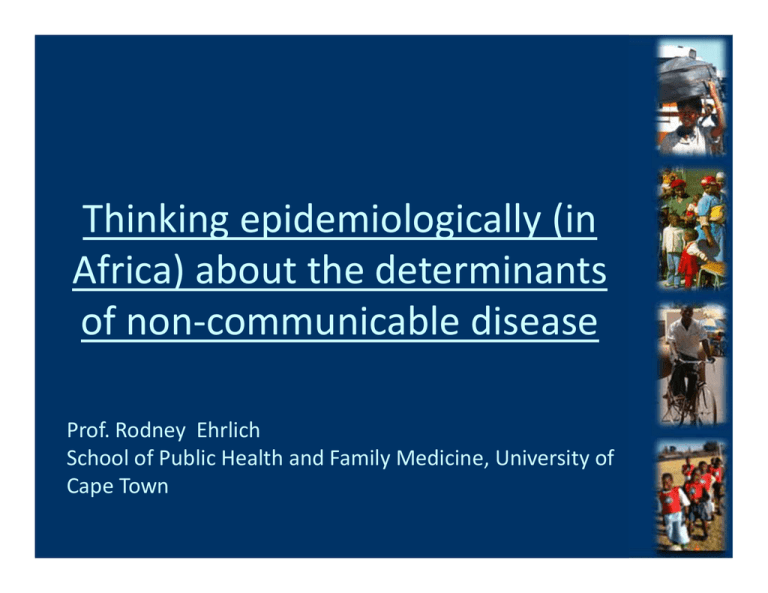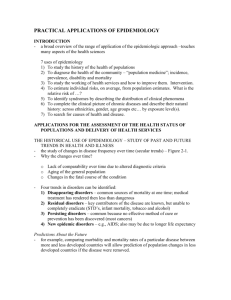Thinking epidemiologically (in Africa) about the determinants of non‐communicable disease Prof. Rodney Ehrlich
advertisement

Thinking epidemiologically (in Africa) about the determinants of non‐communicable disease Prof. Rodney Ehrlich School of Public Health and Family Medicine, University of Cape Town Contents • Study design • Causes of cases vs causes of incidence • Levels of determinants • Life course epidemiology • Implications for disease control and prevention Study design Cross‐sectional studies Risk factor and outcome prevalence surveys. Measure diseases states and risk factors simultaneously. E.g. SA Demographic and Health Survey: chronic bronchitis (cough and sputum) (Ehrlich et al. 2004) Risk factors (descending strength): • History of TB (odds ratio 5 to 6) • Smoking; older; female; • Smoky fuel (women); “Dusts/gases” occupation (men) Strongly protective: • Education (odds ratio 3.3 for >. 12 yrs) Problem: Incidence/prevalence bias Case – control studies Recruit cases of disease – ideally new onset or diagnosis. Recruit controls – difficult! Examine risk factor differences Problem of recall bias. • E.g. INTERHEART study (Steyn et al. 2005) – Factors associated with acute heart attacks across a number of African countries and 3 “demographic groups” (descending OR) overall: • • • • • Lipid markers (apolipoproteins) Diabetes history Hypertension history (highest OR in black African group) Abdominal obesity Smoking Population attributable fraction = 89%! Cohort studies Recruited by exposure or via cohort entry, e.g. birth cohort. Many exposures/risk factors can be examined. Outcomes: different diseases, etc. Allows for the passage of time and long lags between experience or risk factor and disease, and re‐measurement. E.g. (South African) Birth to Ten Study (Levitt et al. 1999) Systolic blood pressure at 5 years associated with: • Weight at 5 years • Height at 5 years • Low birthweight Ecologic studies: HIV and circumcision in 4 regions of Sub Saharan Africa Hargrove 2007 Causes of cases vs causes of incidence Rose (1985): Do the differences between cases and non‐cases explain the differences between populations? “Variation paradox” : To find a causal or predictive risk factor in a population, it has to vary sufficiently within the population. If it doesn’t vary sufficiently, you require a: ‐ comparison between populations, or ‐ comparison of same population over time if risk factor varies over time Cross‐population comparisons: systolic blood pressure “Elevated > 140” NCD Epidemiology for Africa Rose 2001 Ecologic study: death rate from coronary heart disease vs water hardness (Ca, Mg content) Rose 1985 Limited Gradient – no association Wider gradient – inverse association apparent % Hypertension (>=140/90 mmHg) Prevalence of hypertension in African‐origin populations 35 31.3 30 22.8 25 24.1 South Africa St.Lucia 25.9 19.1 20 15 24.4 14.2 14.7 Cameroon (rural) Nigeria 10 5 0 Jamaica Cameroon (urban) Cooper et al., 1997; Steyn et al., 2001. Barbados US (Maywood) Slide courtesy Prof. K. Steyn To summarise Within population (“causes of cases”): • Large variation in susceptibility factors (e.g. genetic) • Large variation in some risk factors, e.g. smoking • Little or no variation in some important risk factors (e.g. dietary fat, contextual factors) Between populations (“causes of incidence”) • Relatively little variability in genetic factors; • May be large variation in population level risk factors What are these population level risk factors that “apply to everyone” ? Policy or intervention factors (Visible) Medical care (e.g. comprehensive primary care) Availability of screening (e.g. cancer cervix) Control of alcohol sales Road traffic control Socioeconomic or sociocultural (social determinants) (Invisible) Income inequality “Neighbourhood” e.g. crime, environmental degradation Food environment Linkages (social capital, cohesion, solidarity) Levels of determinants Socio‐ecological model for factors shaping health behaviour and health outcomes ‘Social Ecology ‐ the study of the influence of the social context on behaviour, including institutional and cultural variables. (Sallis & Owen, 2002) Russian doll framework: diabetes Heredity; foetal nutrition; childhood energy balance; infection, Community and social body size norms; food labelling rules; food subsidies; Structural Biological Dietary habits; Physical activity Behavioural Societal Food production and trade patterns; food costs and technology; income distribution Odds of hypertension in urban West Africa: interaction with social disparities ** ** ** * ** ** ** * (Niakara et al., Trans Royal Soc Tropical Med Hygiene 2007; 101: 1136-1142) * Slide courtesy Prof. V. Lambert Built environment a contextual factor: physical activity (Can we extrapolate from Global North?) London Copenhagen Dar Es Salaam Kampala Nairobi (Forrest KY et al., Med Sci Sports Exerc. 2001 Sep;33(9):1598-604) Where does “lifestyle” or “choice” fit in? Developmental vs degenerative processes Life course epidemiology Intergenerational circle of undernutrition and poverty: risk of cardiovascular disease (CVD) Slide courtesy Prof. V.Lambert “Accumulation of risk” models 1. With independent and uncorrelated insults or risk factors E.g. genetic predisposition plus smoking 2. With correlated insults: • • ‘Risk clustering’ : E.g. high fat diet + smoking + lack of exercise + lower SES adult cardiovascular disease • “Standard model” • Confounding a problem in epidemiological studies ‘Chains of risk’ with additive or trigger effects E.g. paternal alcoholism family dysfunction childhood abuse adult depression Ben Shlomo and Kuh “Critical period” models 1. With or without added later life risk factors: E.g. decreased infective exposure childhood asthma 2. With later life effect modifiers: E.g. low birth weight + accelerated weight gain in childhood and later life increased risk of CVD, diabetes and hypertension Developmental vs degenerative model: lung function “Normals” Smokers Poor childhood nutrition NCD Epidemiology for Africa Disease control/prevention NCD Epidemiology for Africa Approaches to cardiovascular primary prevention (i.e. avoid development of new cases) « Population or low risk strategy » « Individual or high-risk strategy » • Public health approach • Targets entire population • Seeks small changes in highly prevalent risk factor • Radical attempt to deal with underlying causes • Screening & treatment of risk factor • Targets selected individuals • Seeks to identify people with high risk and treat them • Rescue operation (delays consequences) Bovet, P., Building Capacity “Population” strategy vs high‐risk strategy Combined strategies Risk factor Risk factor Density distribution High risk approach Distribution density Distribution density Original distribution Distribution density Population (low risk) approach Risk factor Risk factor Bovet P., IUHPE/CDC Seminar Series: Building Capacity for CVD Health Promotion and Chronic Disease Prevention and Control in Africa, Entebbe, Uganda July 2009 High risk strategy, e.g. screen and treat Advantages Disadvantages • Intervention appropriate to individual • Difficulties and high costs of screening individuals; • Subject motivation higher (own health) • Palliative and temporary—not radical. Have to repeat in each generation; Limited potential for (a) individual (b) population; • • • Physician motivation higher (own • patient’s health) Benefit: risk ratio viewed as favourable (if there is any risk, balanced by observable benefit) Rose 1985 • Predictive power of risk factors low; relative risk may be high, but attributable fraction may be low; • Behaviourally “inappropriate” (individual has to deviate from norm). Low risk strategy (e.g. regulate) Advantages Disadvantages • Small benefit for individuals (‘prevention paradox’) • Need for mass change is hard to communicate. (Poor motivation of • Can be sustained when life‐style individuals – most people regard considered ‘the norm’ themselves as low risk) • Resisted by vested interests • Does not require cooperation from • Doctor motivation weak individuals • Benefit: risk ratio worrisome ‐ if any significant costs or risks ‐ because so • Can target unaware groups widespread (e.g. universal vaccination). • Evidence of ‘macro’ measures hard to demonstrate • Large potential benefit for entire community Rose 1985





